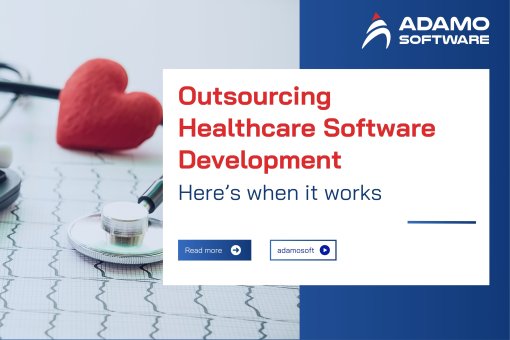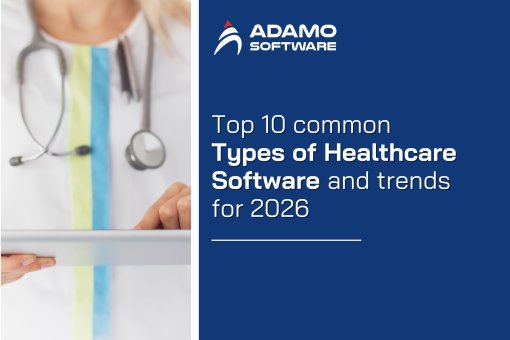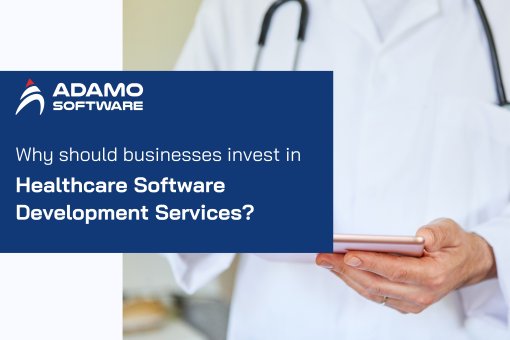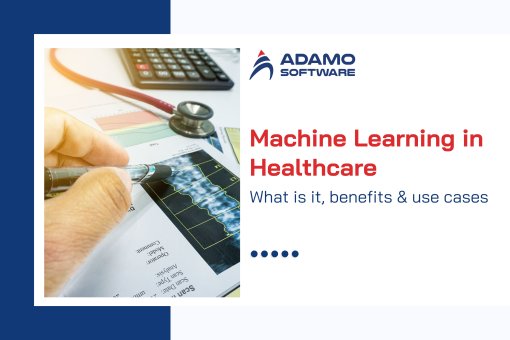How to Estimate Cost to Develop Healthcare Software Solution

With the strong development of science and technology, the current healthcare system has undergone great changes, becoming more convenient, modern, and scientific. Instead of dense medical records, healthcare software is increasingly popular due to its convenience and the quality and performance it brings. Healthcare software has revolutionized patient care by empowering patients, medical staff, and administrators.
To effectively manage diseases and support the patient journey, comprehensive healthcare solutions must integrate a variety of essential features. Determining the cost of developing such a solution is critical for healthcare providers. Let Adamo Software navigate through the cost of different healthcare software development.
Through this blog post, you will find detailed information on the feature set for successful healthcare solutions and types of the healthcare software development process. Key factors affecting healthcare software product development and the timeline of custom healthcare software development services are also discussed. Additionally, this blog post also delves into the ways to minimize healthcare software solutions costs. All the information is well-researched and updated.
So, let’s read our post and get some insights about the healthcare custom software development costs!
I. Feature Set for Successful Healthcare Software Solutions
Developing successful healthcare software solutions involves the integration of various features that address the needs of patients, providers, and administrators. Let’s find some key features to consider for achieving the success of software solutions for the healthcare sector.

1. Patient management
Patient management is a critical component of all healthcare software solutions. Through this feature, healthcare software solutions enable healthcare facilities to record patient information accurately. Besides, they can easily access and efficiently manage these data. Here’s an in-depth look at the essential aspects of patient management.
- Electronic health records (EHR)
An EHR securely stores comprehensive patient health information. These pieces of information include demographics, medical history, test results, medical histories and diagnoses, etc. It allows healthcare providers to update patient information in real time, ensuring the most current data is available for treatment decisions. Besides streamlining healthcare processes, an EHR also supports healthcare software solutions by notifying patients of scheduled tests and easily tracking prescriptions. Additionally, it ensures seamless integration and data sharing with other healthcare systems and providers, enhancing continuity of care.
- Patient Portal
A patient portal is also crucial in patient management. Through this portal, patients can view their health records, test results, and treatment plans. Besides, they can also view their billing statements, make payments, and manage their financial responsibilities.
- Appointment scheduling
The patient management feature of healthcare software solutions allows patients to make online bookings. The process of scheduling appointments will be simplified.
Overall, the patient management feature is fundamental for the success of any healthcare software solution. It helps healthcare providers deliver effective care while patients benefit from improved access to their health information and services.
2. Clinical management
Clinical management is also an essential feature of healthcare software solutions. Effective clinical management relies on robust software tools and functionalities that streamline workflows, support informed decision-making, and optimize patient care. Key components of clinical management within healthcare software solutions include electronic prescribing, lab integration, care plans, and chronic disease management. Let’s explore each component!
- Electronic prescribing
Electronic Prescribing (E-Prescribing) is a critical aspect of clinical management in healthcare software solutions. It enables providers to send prescriptions directly to pharmacies electronically. This significantly reduces errors and improves the efficiency of the prescription process.
The system seamlessly integrates with clinical decision support tools, providing alerts for potential risks like allergies or drug interactions. This comprehensive approach to e-prescribing optimizes medication management, improves patient adherence, and elevates the overall quality of care.
- Lab integration
Lab integration is also involved in clinical management. By enabling electronic ordering of lab tests and imaging studies directly from the patient’s record, it eliminates the need for manual paperwork and reduces the potential for errors. Besides, lab integration systems can send alerts and notifications for abnormal results, ensuring timely follow-up on critical values.
- Care plans, and chronic disease management
Customizable care plans enable healthcare providers to tailor treatment strategies to meet individual patient needs, ensuring comprehensive and continuous care. These tools facilitate the effective management of chronic diseases such as diabetes, hypertension, and heart disease. Integrated patient monitoring and data analytics provide valuable insights into patient health trends and outcomes, allowing for timely interventions.
3. Administrative management
Besides patient and client management, administrative management is also among the features of healthcare software solutions. It involves automated billing, insurance claims, and payment processing. This reduces errors and streamlines financial operations, making it easier for healthcare providers to manage their revenue cycle.
Practice management tools within these systems optimize staff scheduling, resource allocation, and clinic operations. They enhance overall efficiency by streamlining workflows and minimizing downtime. In addition, with the comprehensive reporting and analytics functions of this feature, healthcare facilities can learn invaluable insights into performance metrics, patient outcomes, and financial health.
Besides these main features, healthcare software solutions may also focus on compliance and security, user experience, support and maintenance, and scalability. All of the features help create a comprehensive, efficient, and user-friendly system that meets the needs of all stakeholders in the healthcare ecosystem.
Also read: The Importance of Healthcare IT Solutions Helps Organizations Increase Business Returns
II. Healthcare Software Development Process by Types
The development process for healthcare software is multifaceted and varies based on the specific solution. Let Adamo Software discuss more details on the development process for different types of healthcare software solutions.
1. EHR systems
As mentioned, an EHR system is the place to store patient data. The process of this type of healthcare software development includes analyzing requirements, designing, developing, testing, deploying, and providing maintenance. This development process guarantees that all requests from stakeholders are considered, the system architecture is well-designed, and core modules are developed. The testing process ensures the system meets performance, security, and usability standards.
2. Telemedicine platforms
Telemedicine technology has become important, especially in areas where healthcare services are limited or inaccessible. A telehealth platform is among the healthcare website development types that support this. It allows remote consultations between patients and healthcare providers through video conferencing and secure messaging. The development process involves needs assessment, prototyping, core development, integration, testing, and launching and supporting.
3. Mobile health apps
Like other types of healthcare software solutions development, the process of generating mobile health apps also starts with market research. This step identifies user needs and the competitive landscape and defines the app’s unique value proposition and target audience. Once you have finished doing market research, it’s time for conceptualization, design and development, integration and testing, and launching. After that, post-launching support is also needed.
Overall, the development of healthcare software solutions requires a tailored approach for each specific type. By following a step-by-step process, the final product can meet the needs of users and improve healthcare delivery.
III. Key Factors Affecting Healthcare Software Development Cost
Different types of healthcare software solutions have different costs to develop. For example, the cost to build an EHR system ranges from USD 10,000 to USD 250,000 while they are from USD 40,000 to USD 400,000 for telemedicine platforms. So, which factors affect these development costs? Let Adamo Software answer this question.

1. Scope and complexity
The scope and complexity of the healthcare software solution determine their cost for development. If the healthcare software integrates complex functions and features, it will cost more and take more time and effort to finish the software. These features can be AI-based decision support, advanced analytics, integration with wearable devices, etc. A clearly defined project scope and detailed requirements are foundational for effective cost management. This reduces unforeseen expenses and ensures that resources are allocated efficiently.
2. Regulatory compliance
Ensuring HIPAA compliance is critical for protecting patient information and maintaining trust in healthcare services. You should ensure your healthcare software solutions adhere to the Health Insurance Portability and Accountability Act (HIPAA) regulations. Adherence to stringent regulatory standards significantly increases the complexity and cost of healthcare software development. Besides, obtaining certifications related to healthcare standards can be expensive and time-consuming, impacting the overall budget.
3. Integration requirements
The ability to integrate with existing systems of healthcare software solutions is also among the key factors affecting the development cost. Integrating healthcare software with existing Electronic Health Record (EHR) or Electronic Medical Record (EMR) systems necessitates substantial effort to guarantee compatibility and seamless data transfer.
Besides, additional development and testing costs are needed to incorporate third-party application programming interfaces and services. These third parties can be payment getaways, telehealth platforms, laboratory information systems, etc.
4. Technology stack
The more platforms you want to develop your software; for example, web, iOS, or Android, the more it costs you. This is due to the need for separate codebases or complex cross-platform solutions. Besides, leveraging advanced technologies like machine learning, blockchain, and IoT demands specialized expertise, which can be more expensive to procure.
5. Development team composition
Your team decides the cost of your healthcare software solutions development. You may want to choose an in-house team or outsource to a third-party vendor. Outsourcing can be cost-effective but requires careful vendor selection and management. Besides, the size of the development team and their level of expertise. Specialized skills such as cybersecurity experts, and data scientists, can be more expensive.
6. Design and user experience
To optimize healthcare software efficiency, significant investment in designing and implementing intuitive user interfaces and experiences is needed. Investing in high-quality, user-friendly design increases upfront costs but can lead to better user adoption and satisfaction. If your healthcare software solutions are aimed at disabled users, the design and development costs will be higher. Thorough user research, rigorous usability testing, and iterative refinements are the expensive costs of development.
7. Testing and quality assurance
To make sure that your healthcare software runs smoothly, regular testing is required. Rigorous testing for functionality, performance, security, and compliance leads to higher costs due to the extensive testing cycles. Besides, involving actual users in the testing process to gather feedback and make adjustments adds to the overall project cost.
8. Maintenance and support
Maintenance and support are also factors affecting the development cost of your healthcare software solutions. Post-launch support and maintenance (e.g., bug fixes, updates, regulatory compliance changes) require ongoing investment. Providing customer support services for users can add to operational costs.
Overall, these factors help to make informed decisions about the scope, technology, and resources required for healthcare software development. This empowers effective budgeting and cost management, leading to successful healthcare software development initiatives.
IV. Timeline of Custom Healthcare Software Development Services
Depending on the complexity, scope, and specific requirements, the timeline of custom healthcare software development can vary. Let’s outline the general phases involved in this journey.

1. Initial consultation and planning
This phase involves meeting with stakeholders to understand needs and objectives. In addition, it establishes the foundation for the project, including defining the project scope, key features, and deliverables. A thorough feasibility study assesses technical viability and resource requirements, culminating in a high-level project timeline and budget estimate. The project team is assembled and roles and responsibilities are clearly outlined. The whole process takes you about two to four weeks.
2. Research and analysis
During the research and analysis phase, you will do market research to analyze market trends and competitors’ healthcare software solutions. Besides, you will have to conduct surveys and interviews with potential users to gather insights. Moreover, evaluating the technology stack, third-party integrations, and compliance requirements is also needed. This phase will last for three to five weeks.
3. Designing phase
The designing phase normally lasts four to eight weeks. It involves wireframing and prototyping for key screens and user flows. Besides, you will also have to develop a user interface design to ensure a user-friendly experience and conduct usability testing at this stage.
4. Development phase
It will take you 12 to 24 weeks to finish this phase which focuses on building the software’s core functionalities. Backend development establishes the server-side infrastructure, including database structures and application programming interfaces (APIs). Simultaneously, frontend development creates user-friendly interfaces that seamlessly integrate with the backend. Core features like patient records, appointment scheduling, and billing are implemented during this stage. Robust security measures, including data encryption, access controls, and adherence to regulations like HIPAA and GDPR, are implemented throughout the development process.
5. Testing
The testing phase spans 6-10 weeks, including unit testing, integration testing, performance testing, security testing, and user acceptance testing. Unit testing is the first and foremost step in the testing phase. It is where individual components and modules are rigorously tested to verify their functionality. The other four tests are also essential to make necessary adjustments and enhancements before the final deployment.
6. Deployment and training
The deployment and training phase of your healthcare software solutions will last for three to six weeks. This phase ensures that the software is fully operational, users are comfortable and proficient, and any initial issues are promptly resolved.
Overall, the estimated total timeline to develop your healthcare software solutions is about 6 to 12 months. The actual timeline may vary depending on the complexity of the software, the number of features, the size of the development team, and other factors such as regulatory compliance and integration needs.
V. Expert Tips to Minimize Healthcare Software Solutions Cost
As mentioned, the cost of developing healthcare software solutions can be expensive due to many factors. However, with strategic planning and careful execution, it’s possible to reduce expenses. Let’s explore some expert tips to save costs.

1. Defining clear requirements
Defining clear requirements is essential to cut down on the cost of healthcare custom software development. First, you may need to engage with all stakeholders to gather comprehensive insights into their needs and expectations. These stakeholders include healthcare providers, administrators, and IT staff. Let’s outline the scope of your healthcare software solutions project, key functionalities, user roles, and specific workflows.
2. Choosing the right technology stack
Choosing the right technology stack is also an ideal way to save the developing healthcare software solutions costs. Opt for open-source tools and frameworks where possible, as they can significantly reduce licensing fees and provide robust, community-supported solutions. Choose scalable technologies that can accommodate future growth, minimizing the need for costly system migrations or extensive redevelopment.
3. Leveraging cloud services
Cloud services help reduce the cost of healthcare software solutions by offering scalability options that can accommodate growth without significant upfront costs. By utilizing cloud platforms, you can easily scale resources up or down based on demand, ensuring you only pay for what you use. Leveraging cloud providers offer significant advantages in disaster recovery and data protection. This enhances data protection without the high costs associated with traditional solutions.
4. Planning for regulatory compliance early
Planning for regulatory compliance early is also essential to minimizing costs for healthcare software solutions. Engaging with compliance experts at the beginning ensures that your software architecture and data handling processes meet all necessary legal standards. Early compliance planning also helps in identifying potential regulatory risks and addressing them proactively, which can save significant time and resources later.
In general, by adopting the above strategies, healthcare organizations can develop cost-effective software solutions that meet their needs while maintaining high standards of quality and compliance.
VI. How Adamo Help You Develop Healthcare Software Solutions with Reasonable Cost
When it comes to developing robust, secure, cost-saving, and user-friendly healthcare software solutions, choosing the right development partner is crucial. Adamo Software can be your trusted partner for this.

As one of Vietnam’s leading app development companies with experienced and professional experts, we are confident in delivering high-quality healthcare website solutions. Telehealth/ telemedicine solutions, remote patient monitoring, on-demand healthcare solutions, and wearable medical devices, are valuable solutions that we offer.
Here’s how we can help you develop healthcare software solutions at a reasonable cost.
- Clear requirement definition
- Flexible project management framework
- Choosing the Right Technology Stack
- Balancing in-house expertise with strategic outsourcing
- Leveraging cloud services
- Providing automated testing
By implementing these strategies, Adamo will help you develop cost-effective software solutions that meet your needs while maintaining high standards of quality and compliance. This approach ensures that you receive robust, scalable, and compliant healthcare software solutions without exceeding your budget.
Still confused about choosing a unit to help you with your healthcare software development? Don’t hesitate to contact us now.











